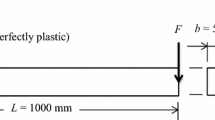Abstract
Finite element simulation has become an important tool of process and production design in various fields, especially in the automotive industry. The calculation of forming processes in the early concept phase of new cars allows virtual adaptions, which can reduce costs of later phases in the product development significantly. Therefore, the precise characterization and modelling of the material behavior is necessary to ensure a robust and reliable numerical process design. The mechanical properties of numerous materials are highly influenced by the rolling or extrusion direction in the production process. This necessitates the characterization of materials in different loading directions. However, depending on the dimensional aspects of the semi-finished product, the manufacturing of specimens can be challenging or even impossible. Thus, in this investigation, an innovative, indirect approach for the identification of the Lankford coefficient in transversal direction is presented. Based on numerical and experimental data of layer compression tests the Lankford coefficient is determined by inverse modelling of the resulting specimen contour. Due to the characteristics of the layer compression test, it can even be used for semi-finished products with small transversal dimensions like extruded profiles. The presented methodology is on the one hand verified by conventional uniaxial tensile tests for aluminum as well as steel blank material. On the other hand it is used to determine Lankford coefficients for an aluminum extrusion hollow profile and the inversely identified material model is validated by comparison of strain distributions of experimental and numerical square tube bending tests.

















Similar content being viewed by others
Abbreviations
- Fmax :
-
maximum process Force.
- vtool :
-
tool velocity.
- rtools :
-
radius of bending tools.
- t0 :
-
material thickness.
- Ddisk :
-
diameter of layer compression test specimen.
- Layerdisk :
-
layers of specimen stack.
- n:
-
number of experimental tests.
- SDexp :
-
standard deviation of experimental tests.
- w:
-
width of extrusion profile.
- h:
-
height of extrusion profile.
- l:
-
length of extrusion profile.
References
Aegerter J, Keller S, Berk H (2017) Miniaturisierung des Zugversuchs zwecks Ermittlung lokaler Bauteileigenschaften - Versuchstechnik und Vergleich mit Ergebnissen an Standardproben. Tagung Werkstoffprüfung 2017 - Fortschritte in der Werkstoffprüfung für Forschung und Praxis 117–122
Konopik P, Farahnak P, Rund M, Dzugan J, Rzepa S (2019) Applicability of miniature tensile test in the automotive sector. IOP Conf. Ser.: mater. Sci Eng 461:1–6
Suttner S, Merklein M (2016) Influence of specimen size and sheet thickness on the material behavior of AZ31B under uniaxial tension. IOP Conf. Ser.: mater. Sci Eng 159:1–8
Kohyama A, Hamada K, Matsui H (1991) Specimen size effects on tensile properties of neutron-irradiated steels. J Nucl Mater 179-181:417–420
Kanni Raj A (2010) Calculation of Lankford coefficient from orientation distribution function and modelling of forming limit diagram using Marcniak-Kuczynski hypothesis of geometric instability. Indian J Eng Mater Sci:256–264
Hammami W, Delannay L, Habraken AM, Duchêne L (2009) Crystal plasticity prediction of Lankford coefficients using the MULTISITE model: influence of the critical resolved shear stresses. Int J Mat For 65-68
Butz A, Pagenkopf J, Baiker M, Helm D (2016) The concept of virtual material testing and its application to sheet metal forming simulations. J Phys Conf Ser 734:1–4
Yoon J, Dick R, Barlat F (2008) Analytical approach to predict anisotropic material properties from cup drawings. Int J Mat Form 301-304
Gösling M (2017) A method to determine lankford coefficients (r-values) for ultra high strength low alloy (UHSLA) steels. J Phys Conf Ser 896:1–6
Chamekh A, Ben Hadj Salah H, Hambli R (2009) Inverse technique identification of material parameters using finite element and neural network computation. Int J Adv Manuf Technol 173-179
Cooreman S, Lecompte D, Sol H, Vantomme J, Debruyne D (2008) Identification of mechanical material behavior through inverse modeling and DIC. Exp Mech 421-433
Güner A, Soyarslan C, Brosius A, Tekkaya AE (2012) Characterization of anisotropy of sheet metals employing inhomogeneous strain fields for Yld2000-2D yield function. Int J Solids Struct 49(25):3517–3527
Merklein M, Kuppert A (2009) A method for the layer compression test considering the anisotropic material behavior. Int J Mater Form 2(S1):483
Tuninetti V, Gilles G, Péron-Lührs V, Habraken A (2012) Compression test for metal characterization using digital image correlation and inverse modeling. Procedia IUTAM 4:206–214
Lankford WT, Snyder SC, Bausher JA (1950) New criteria for predicting the press performance of deep drawing sheets. Trans ASM 42:1197–1205
Goedel V, Merklein M (2011) Variation of deep drawing steel grades’ properties in dependency of the stress state and its impact on FEA. Int J Mater Form 4(2):183–192
Acknowledgements
The authors would like to thank the German Research Foundation (DFG) for supporting the present investigations which were performed within the scope of the research project “Improvement of formability of extruded aluminium profiles by a local short-term heat treatment (DFG ME2043/45-2)”.
Author information
Authors and Affiliations
Corresponding author
Ethics declarations
Conflict of interest
The authors declare that they have no conflict of interest.
Additional information
Publisher’s note
Springer Nature remains neutral with regard to jurisdictional claims in published maps and institutional affiliations.
Rights and permissions
About this article
Cite this article
Graser, M., Lenzen, M. & Merklein, M. On the inverse identification of Lankford coefficients using geometrical changes under quasi-biaxial loading. Int J Mater Form 12, 1053–1061 (2019). https://doi.org/10.1007/s12289-019-01498-z
Received:
Accepted:
Published:
Issue Date:
DOI: https://doi.org/10.1007/s12289-019-01498-z




